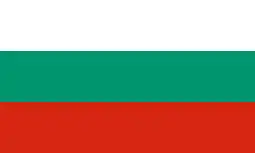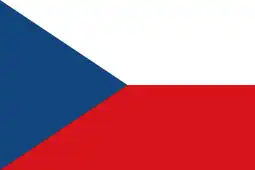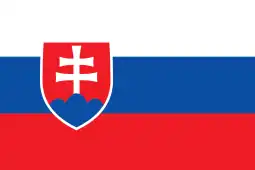Avia B.122
The Avia B.122 was a Czechoslovak single-seat biplane aerobatic aircraft, which was developed in the mid-1930s. It saw some service in the first years of World War II.
| B.122 | |
|---|---|
 | |
| Series of Ba.122s for Soviet Union | |
| Role | aerobatic trainer aircraft |
| Manufacturer | Avia |
| Designer | František Novotný |
| First flight | 1934 |
| Primary users | Czechoslovak Air Force Slovak Air Force Soviet Air Forces Luftwaffe |
History
In the spring of 1934, the Czechoslovak Army Command decided that some Czechoslovak Air Force pilots would participate in the international aerobatic competition Coupe Mondiale held at Vincennes, Paris, on 9–10 June. For this purpose, the Czechoslovakian aircraft manufacturer Avia was given the task of designing and constructing an aircraft. The prototype, B.122, was presented after only six weeks.
The Czechoslovak pilots had only a few weeks to learn and master the aircraft as the competition was to be held in July 1934. Luckily, the design was quite successful and the Czechoslovak pilots managed to win the 4th (František Novák) and the 8th (Ján Ambruš) place in the competition.
Afterwards, the aircraft was modified, based on the pilots' inputs, and this resulted in the improved version, Ba.122. The Ba.122 was equipped with larger rudder and ailerons on both upper and lower wings. On the occasion of 1936 Summer Olympics in Berlin International Aerobatic Contest, "Internationaler Kunstflugwettbewerbs" was run by the German Aeroculub, "Aeroklub von Deutschland". Czechoslovak pilots won 2nd (Petr Široký), 3rd (František Novák) and 8th place (Ján Ambruš) [1] with their Avias. In this contest new engine Avia RK-17 was introduced, with aircraft Ba.122.7 (OK-AWE), Ba.122.8 (OK-AWA). 1937 was also a successful year, as the Avias managed to win 1st and 3rd place at the International Aviation Meeting in Zurich in July/August 1937.[2] Some of these aircraft were equipped with nine-cylinder Walter Pollux engines to fit into category of aeroplanes with engines above 20L. These successes led to export orders from the Soviet Union and Romania. The aircraft was later further developed into prototypes Ba.222, Ba.322 and Ba.422. The Czechoslovak Ministry of Defence ordered 45 Bs.122 trainers. However, the outbreak of World War II put an end to further development. Some Avias ended up in the German Luftwaffe when parts of Czechoslovakia were absorbed into Nazi Germany in 1939. Other aircraft were sold to the Slovakian and Bulgarian air forces.
Variants

- B.122
- 3 prototype machines with Walter Castor II engine, B-122.2 and .3 later modified to Ba.122 standard
- Ba.122
- improved variant with ailerons on both wings and enlarged rudder, mostly with Avia RK-17 engine
- Ba.222
- Ba.122 with NACA cowling and wheel pants
- Ba.422
- Ba.122 with upper gull wing to improve front visibility in inverted flight
- Bš.122
- Military trainer variant of the Ba.122, staggered wings, Walter Castor II engine
- B.322
- Bš-122 with enclosed cockpit and Townend cowling
Production
- B/Ba.122: 60 machines, serials B.122.1-Ba.122.45, Ba.122.101-115 (series for Soviet Union)
- Bš.122: 45 machines
- Ba.222: one prototype
- Ba.322: one prototype
- Ba.422: 2 machines
Operators
_pic3.JPG.webp)
 Bulgaria
Bulgaria- Bulgarian Air Force – 12 Bs 122 aircraft taken over from the Czechoslovak Air Force, named ″Vosa″ (″Wasp″) [3]
 Czechoslovakia
Czechoslovakia- Czechoslovakian Air Force – 45 Bš.122 and 45 B/Ba.122 aircraft
.svg.png.webp) Germany
Germany- Luftwaffe – 12 aircraft taken over from the Czechoslovak Air Force
 Romania
Romania- Royal Romanian Air Force – one machine, Ba-122.40, YR-DPO
 Slovakia
Slovakia- Slovak Air Force (1939–45)
 Soviet Union
Soviet Union- Soviet Air Force – 15 Ba.122 aircraft
Specifications (Ba.122)

Data from Němeček, Václav – Československá letadla [4]
- Crew: 1
- Length: 6.80 m (22 ft 4 in)
- Wingspan: 8.85 m (29 ft 0 in)
- Height: 2.84 m (9 ft 4 in)
- Wing area: 22.55 m2 (242.7 sq ft)
- Airfoil: Clark Y
- Empty weight: 780 kg (1,720 lb)
- Gross weight: 1,080 kg (2,381 lb)
- Powerplant: 1 × Avia RK-17, 310 kW (420 hp)
Performance
- Maximum speed: 270 km/h (168 mph, 146 kn)
- Cruise speed: 230 km/h (143 mph, 124 kn)
- Range: 575 km (357 mi, 310 nmi)
- Service ceiling: 7,000 m (22,300 ft)
- g limits: +18,-12 ultimate
- Time to altitude: 6 min to 10,000ft
- Power/mass: 3,5 kg/kW, 5,66 lbs/hp
References
- Rajlich, Jiří (2016). Hobby Historie 35, Berlín 1936 a účast československých letců. Prague.
{{cite book}}: CS1 maint: location missing publisher (link) - Kareš, Marcel; Rajlich, Jiří (2017). Curych 1937: Účast československých letců na IV. mezinárodním leteckém mítinku v Curychu v roce 1937. Prague: Mladá fronta.
- Ovčáčík, Michal (2009). REVI 2009/76, Avia Bš-122 Vosa v Bulharském královském letectvu. Prague. pp. 31–33.
{{cite book}}: CS1 maint: location missing publisher (link) - Němeček, Václav (1968). Československá letadla. Prague.
{{cite book}}: CS1 maint: location missing publisher (link)